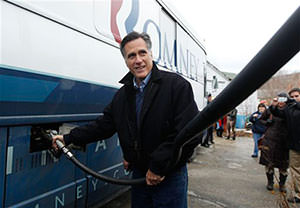Uncle Mitt Feels Your Pain
The pain of the Great Recession lingers, remaining a big obstacle to President Barack Obama's hopes for re-election.
The pain of the Great Recession lingers, remaining a big obstacle to President Barack Obama’s hopes for re-election. Fewer than half of the 8.6 million jobs lost since the recession began have come back. The long-term unemployed are a permanent feature of the national landscape.
These figures are well known. But they deserve a closer examination now that Obama’s probable opponent, Mitt Romney, has emerged from the primaries and is preparing to ditch the right wing for something approximating the center. Despite a modest recovery, these years of hard times have left a legacy of fear that Obama must counter. Last week, I wrote of the efforts of Obama’s grass-roots workers. But their dedication may not be enough to overcome the weakness of the economy and Romney’s well-financed efforts to place the blame on the president.
The slowness of recovery was documented in the nonpartisan, liberally oriented Center on Budget and Policy Priorities’ latest report on the economy, the Legacy of the Great Recession. Although the report credits the stimulus measures of the last days of the Bush administration and the beginning of Obama’s term with staving off the worst possible results, it points out the difficulty facing a president who needs to convince a shaken electorate of his successes.
“The economy still faces a long and difficult climb out of the jobs hole created by the recent recession,” the report said. “The private sector created, on average, about 162,000 jobs a month in the past 25 months — a pace somewhat faster than population growth. That has contributed to a decline in the unemployment rate, but much faster job growth will be needed to restore normal labor force participation.
“The jobs deficit from this recession is much larger than those in previous recessions. The economy would have to create an average of 215,000 jobs each month for the next two years just to return to the December 2007 level of employment — and even more to restore full employment, since the population and potential labor force are now larger. Economic growth will have to remain strong in the next few months to see a strong jobs recovery begin.”
“It’s clear to every American that there will still be ups and downs along the way and that we’ve got a lot more work to do,” Obama said when the less-than-expected job increase figures came out Friday.
Polling information isn’t worth much at this early stage, but the Real Clear Politics website’s average of surveys shows Obama leading Romney 48.2 percent to 43.5 percent. More people approve of the president’s job performance — 48 percent — than disapprove, 46.5 percent. In addition, unemployment is declining in some of the states Obama needs to win.
In Colorado, unemployment has dropped to 7.8 percent from a recession high of 8.6 percent. “The figures mean our recovery is on track,” economist Patricia Silverstein of Littleton, Colo.-based Development Research Partners told The Denver Post. In the key state of Ohio, unemployment, which peaked at more than 10 percent at the end of 2009 and the beginning of 2010, is now 7.7 percent.
But there’s one figure that should worry the Democrats. A total of 60 percent think the country is headed on the wrong track, compared with 33.7 percent who think it is going in the right direction. I think this, to a great extent, reflects pervasive fear over unemployment.
Romney and his budget-cutting ally, Rep. Paul Ryan of Wisconsin, have offered little comfort. Their answer is cutting taxes, including a 25 percent reduction in corporate taxes along with a sharp reduction in spending in a category called non-defense discretionary spending. This includes, according to the Economic Policy Institute, spending for veterans, safety net programs such as housing vouchers, nutrition assistance for women and infants, and consumer and environmental protection. As Ezra Klein wrote in his Washington Post Wonkblog, “The cuts to Medicaid and other health programs for the poor are twice the size of those to Medicare. The cuts to education, to food stamps, to transportation infrastructure and to pretty much everything else besides defense are draconian. As for the tax reform component, it cuts taxes on millionaires by more than $250,000, but it doesn’t name a single loophole or tax break that Ryan and the Republicans would close.”
This is frightening stuff. But Romney’s image makers are remaking him. He’s losing the hard edges of his primary campaign. Thomas B. Edsall noted in The New York Times Campaign Stops blog that Romney, after winning the Wisconsin, District of Columbia and Maryland primaries, said: “And the most vulnerable have been hurt the most — over 30 percent of single moms are struggling in poverty.” This was a contrast to what he said on CNN in the heat of his primary fights: “I’m not concerned about the very poor. We have a safety net there.” After saying this, he embraced the Ryan budget plan that would eviscerate the safety net.
Count on this: Romney, the corporate downsizer, will be put in storage until after the election, replaced by kindly, reasonable Uncle Mitt, surrounded by wife and sons. Let’s hope a nation traumatized by the Great Recession, seeing recovery proceeding far too slowly, doesn’t fall for his act.
Your support matters…Independent journalism is under threat and overshadowed by heavily funded mainstream media.
You can help level the playing field. Become a member.
Your tax-deductible contribution keeps us digging beneath the headlines to give you thought-provoking, investigative reporting and analysis that unearths what's really happening- without compromise.
Give today to support our courageous, independent journalists.






You need to be a supporter to comment.
There are currently no responses to this article.
Be the first to respond.